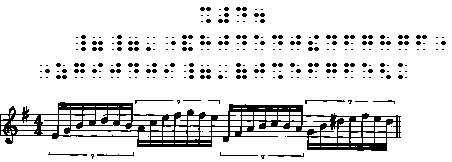|
(Table 4)
4-1. In print, smaller notes are often joined by one or more horizontal beams
into beats or portions of beats. Eighth notes are joined by one beam,
16th notes by two beams, 32nd notes by three beams, etc. Braille duplicates
that practice within certain constraints.
4-2. Three or more 16ths or smaller-value notes may be "grouped" in braille.
The members of the group will all be in the same beat or portion of a beat
and have the same value. When "grouped", only the first note of the braille
group contains dots 3 and/or 6 as necessary. The other notes in that group
are written as if they were 8th notes.
Example 4-2.

4-3. Because a group ends with notes that look like 8ths, if an
8th note or 8th rest follows in the same measure and is on the same
braille line, all of the notes in the group must be written in their
normal form.
Example 4-3.

4-4. Grouping may be used if a rest of the same value is at the beginning of the group. It must
not be used if a rest appears in any other position in the group.
Example 4-4.

4-5. Grouping is based on the time signature, i.e., in two-four, four-four, etc.
16th notes appear in groups of four; in three-eight, six-eight, etc. 16th notes appear
in groups of six. In general, 16ths are grouped by fours in time signatures with a lower number
of two or four; they are not grouped by four when the lower number is eight or 16.
Thirty-seconds and smaller notes are generally grouped by fours or sixes in rhythmic
portions of beats.
4-6. Grouping may not be used if the group cannot be completed on the same braille line.
Example 4-6.

Signs from Table 1.
   |
Larger values; 8ths and larger |
   |
Smaller values; 16ths and smaller |
  |
Separation of rhythmic groups |
4-7. In a case where syncopated 8th notes might be mistaken for a group of 16ths, the larger-value sign is added for clarity.
Example 4-7.

4-8. When 8th notes are grouped across a bar line in print, the sign
  may be used to
show the separation of rhythmic groups. This same sign is also used in some countries
to show distinction of value between groups. may be used to
show the separation of rhythmic groups. This same sign is also used in some countries
to show distinction of value between groups.
Example 4-8.

4-9. In addition to beams, numbers are also printed above groups of triplets, sextuplets, etc. In braille, these numbers precede the first note of each group and are written as in Table 4.
Signs from Table 4.
   |
Group of two |
 |
Triplet |
   |
Group of three; triplet |
   |
Group of six |
    |
Group of ten, etc. |
4-10. There are two forms to the triplet sign. The single-cell sign is used when there are
no other specially marked rhythmic groups. The three-cell sign is used for a triplet within
a triplet and for passages where there are a number of other marked groups such as duplets,
sextuplets, etc.
Example 4-10.

4-11. Grouping signs may be doubled, but in the case of the three-cell grouping signs it
is unnecessary to use dot 3 after the first of the doubled signs.
Example 4-11.

4-12. When the print does not include appropriate numbers for triplets, sextuplets, etc.,
there are two schools of thought:
1. the number of notes in each group should be inserted as above; or
2. put the sign   between groups. between groups.
|